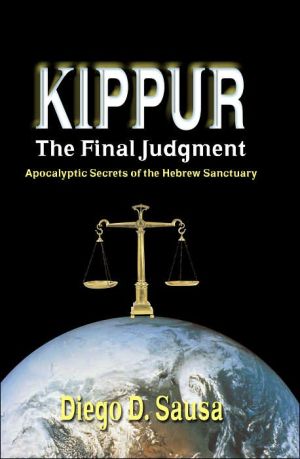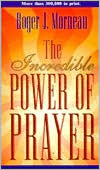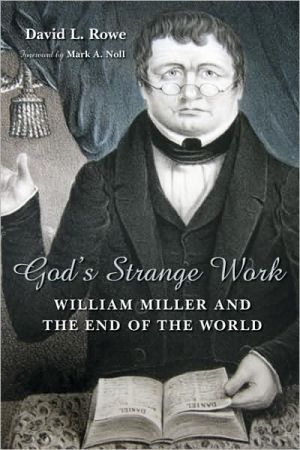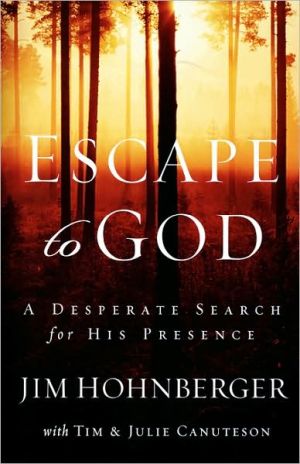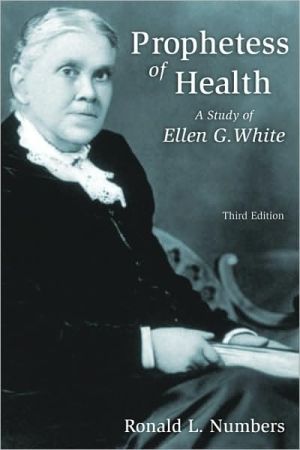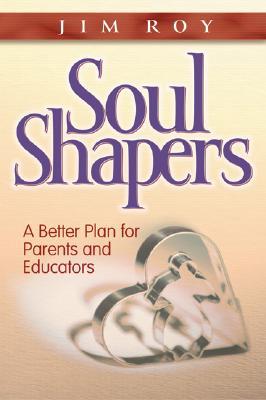Kippur - The Final Judgment
Will mankind be able to eventually resolve the world's current troubles and make it a better and harmonious world to live in, or is mankind on the edge of an unstoppable self-destructive course? Is our world going to end soon? Are we all alone in this vast universe and just happen to exist by chance, or is there a God who is in control? If there is a God, why do bad things happen? What is God doing now?\ \ For the first time, Dr. Sausa, an expert on the subject of the sanctuary, unravels the...
Search in google:
Will mankind be able to eventually resolve the world's current troubles and make it a better and harmonious world to live in, or is mankind on the edge of an unstoppable self-destructive course? Is our world going to end soon? Are we all alone in this vast universe and just happen to exist by chance, or is there a God who is in control? If there is a God, why do bad things happen? What is God doing now?For the first time, Dr. Sausa, an expert on the subject of the sanctuary, unravels the answers to these questions in a profound yet easy to understand presentation in his book, Kippur: The Final Judgment. About two thousand five hundred years ago, a man named Daniel predicted six major events that would transpire centuries ahead of his time even unto the end of the world. The four major events that spanned more than 18 centuries ahead of Daniel's time were fulfilled 100 per cent as he predicted. The 5th major event is the pre-Advent judgment of the world, followed by the 6th which is the Second Coming of Christ. The 5th major event, the pre-Advent judgment that leads to Christ's Second Coming according to Daniel is the real cosmic Yom Kippur that the Hebrew Yom Kippur symbolized. The author demonstrates, through the books of Leviticus, Hebrews, Daniel and Revelation, that this 5th major event that Daniel predicted is happening now, and he shows that we are indeed treading on the final pages of this world's history before the final cosmic mega-cataclysmic change at Christ's coming. He shows us most of all, that now is the time when we can still choose to accept God's infinite gift of eternal salvation instead of eternal obliteration.
KIPPUR: THE FINAL JUDGMENT\ APOCALYPTIC SECRETS OF THE HEBREW SANCTUARY \ \ By Diego Diaz Sausa \ The Vision Press\ Copyright © 2006 The Vision Press\ All right reserved.\ ISBN: 0-9788346-1-5 \ \ \ \ Chapter One\ CHRIST AFTER THE PASSION \ Three days after the Passion and death of Christ on the Cross, He rose again (Matt. 28:1-6; Luke 24:6, 7, 46) and spent His final forty days with His disciples (Acts 1:3) before He ascended back to heaven (Acts 1:9). It is hard to imagine how traumatic the impact of Christ's departure was on His friends. The One who could feed thousands out of a few pieces of bread (Matt. 15:34-38); the One who could command the storm to stop, heal the sick, and raise the dead; the One at whose presence the demons would tremble; the One who they finally realized was their God (Jn. 20:28,29, cf. Col. 2:9), who for the last three and a half years was walking, eating, sleeping, laughing and talking with them, was now leaving. Jesus knew the emptiness that His departure would create. So before His ascension, He did not leave His followers without the firm assurance of "another" (Gk. allos, i.e., of the same kind) One like Him who would take His place - the Holy Spirit (Acts 1:8). And when He had given this assurance, "He was taken up, and a cloud [Christ's Air Force One, e.g. Rev. 1:7, Matt. 21:27] received Him out of their sight" (Acts 1:9). As His Galilean friends stood in awe watching Him disappear "out of the blue," perhaps like a space shuttleevanescing in space, Christ sent two angels to give His friends the absolute assurance that He would come again, visibly descending from the sky in like manner as they saw Him ascend to heaven (Acts 1:10, 11).\ It's been about 2000 years since that promise to Christ's followers was given and the Passion of the Christ. Where is He? What has He been doing these past two millennia? What happened to Him after the resurrection? Did He forget planet Earth after His redemptive sacrifice and head off on vacation to one of His island universes? The answers to these questions are found in the Scriptures - both in the Old and the New Testaments, particularly in the books of Leviticus, Daniel, Hebrews and the Apocalypse (Revelation).\ We often hear sermons and read books about Christ's atoning sacrifice in the past and His glorious coming in the near future, but almost never about what He has been doing from His ascension until the present time. This volume in your hands will delve into this subject, because what Christ is doing now is equally as important as what He did in the past and what He will do in the near future. Christ's activity from His ascension until now ratifies what He did on the Cross and results in the ultimate eternal salvation of God's people and the total annihilation of evil and death forever.\ Somehow, the Christian world in general has missed Christ's crucial intermediary activity between the Cross and His Second Coming. As the astute theologian and literary genius Clifford Goldstein profoundly observes: "Most Christians who study Christology in Revelation deal with Christ as the Lamb at His first coming, the Lion at His second, or both, but they miss His crucial role in between." The Bible gives us clear revelation about what Christ has been doing from His ascension in AD 31, until "He will appear a second time" to save those who eagerly wait for Him (Heb. 9:28).\ Compared to other books of the Bible, the book of Hebrews gives us the most extensive information about Christ's activity after the Cross. "But this Man, after He had offered one sacrifice for sins forever, sat down at the right hand of God" (Heb. 10:12). Jesus Christ, God the Son (Heb. 1:2, 3, 8), ascended to heaven after the Cross and shared the throne of God the Father, to do what? "Now this is the main point of the things we are saying: We have such a High Priest, who is seated at the right hand of the throne of the Majesty in the heavens, a Minister of the sanctuary and of the true tabernacle which the Lord erected, and not man" (Heb. 8:1,2). Christ according to Hebrews is sharing God's throne in the heavenly sanctuary, ministering as our High Priest.\ Like the priests in the old Hebrew sanctuary cultus (sanctuary rites and rituals of worship), which was only a shadow of the real heavenly sanctuary (Heb. 8:5), Christ at His ascension assumed His role as our Intercessor or Mediator to "save [us] to the uttermost" (Heb. 7:25, cf. 1 Tim. 2:5) obtaining eternal redemption for us, not through the merits of the symbolic sacrificial animals, but through the merits of the real Sacrifice on Calvary - Himself (Heb. 9:12). Isaiah expresses the same truth when he says that after "He bore the sin of many ... [He] made intercession for the transgressors" (Isa. 53:12, margin). In other words, Christ after the Cross, did not stop working for the ultimate restoration of mankind. Hebrews tells us that the plan of redemption continued on after the Cross. At His ascension, Christ continued to work for our salvation by assuming the role of High Priest in the heavenly sanctuary that we "may receive the promise of the eternal inheritance" through the application of the merits of His atoning sacrifice (Heb. 9:12, 14, 15). The plan of mankind's redemption is a continuum of Christ's redemptive activities from earth to heaven, from Calvary to the heavenly sanctuary.\ This revelation about Christ's priesthood in the book of Hebrews would not make sense if we divorce ourselves from the Hebrew sanctuary institution which was established by God through Moses. The Hebrew sanctuary is a complete anthropomorphic (expression of the divine in human terms) pattern of the plan of redemption that served not only as a symbol of Christ's sacrifice on the Cross, but also as a predictor of Christ's sequential redemptive activities after the Cross, that will ultimately accomplish mankind's "at-one-ment" with God, and usher in eternity when "the tabernacle of God is with men, and He will dwell with them, and they shall be His people. God Himself will be with them and be their God" (Rev.21:3).\ The Bible writers both in the OT and NT (Old and the New Testaments) viewed salvation within the context of the Hebrew sanctuary typology. When Isaiah said, "He was led as a lamb to the slaughter" (Isa. 53:7); or when John the Baptist declared, "Behold! The Lamb of God, who takes away the sin of the world!" (John. 1:29); or when St. John used the expression in Revelation the "Lamb who was slain" (5:12), and "washed their robes and made them white in the blood of the Lamb" (7:14); or when Peter said, "but with the precious blood of Christ, as of a lamb without blemish and without spot" (1 Pet. 1:19); or when Paul declared that we have "redemption through His blood" (Eph. 1:7) - they were all evoking the Hebrew sanctuary imagery. In other words, Christ's redemptive acts can only be fully understood within the context of the Hebrew sanctuary paradigm. The Bible scholar Roy Naden rightly observes that the use of these types of expressions "... can be understood only in the context of Jewish sacrificial practice." Clifford Goldstein further concretizes this point:\ Divorced from the background of the sanctuary, being washed in blood makes no more sense than does being warmed by ice. Blood doesn't cleanse, it stains - except in the Israelite sanctuary service, where blood did, indeed, cleanse.\ To get a full picture of the gospel, it is necessary to understand the message of the sanctuary since the plan of redemption - the everlasting gospel - is expressed and foreshadowed more fully by the Hebrew sanctuary imagery. In the following chapters, it will be shown that God's redemption, portrayed in the earthly sanctuary institution, did not stop at the offering of the sin sacrifice on the altar of burnt offering (which typified Christ's sacrifice on the Cross). The work of atonement continued on with the intercessory or mediatory ministry of the priests on a daily basis, through the application of the merits of the sin sacrifice on behalf of the penitent sinners, and with the yearly climactic cleansing, and judgment ministry of the high priest on the Day of Atonement which culminated in the total cleansing of all the penitent children of Israel and the entire camp. Each of these Hebrew sanctuary rituals foreshadowed Christ and His complete redemptive activities for mankind until the final judgment. That is, the sin sacrifice foreshadowed His atoning sacrifice on the Cross, the priests' daily mediatory ministry foreshadowed His priestly mediatory ministry in the heavenly sanctuary, and the high priest's climactic Yom Kippur ministry foreshadowed Christ's climactic cosmic Yom Kippur ministry in the heavenly sanctuary that will culminate in the final, eternal restoration of God's people and the annihilation of evil from the entire universe.\ Christ after the Passion (since 31 AD), according to the book of Hebrews, has been performing His mediatory function in the heavenly sanctuary as typified by the daily mediatory ministry of the earthly priests. Both the Cross and Christ's mediation are the first phase of God's salvation. At present, according to the book of Daniel, Christ is performing the second (terminal) phase of God's plan of redemption, His judgment ministry in the heavenly sanctuary which is typified by the Day of Atonement ministry of the Hebrew high priest. Hidden in the imagery of the Hebrew sanctuary liturgy is God's plan for mankind's restoration back to Paradise that was lost by our first parents. This is good news! God revealed through the Hebrew sanctuary symbolism that the way to eternal bliss and perfection was through the Sin Offering on the Cross - the Christ. God's criterion for mankind's ultimate salvation in the final judgment and into eternity remains the same: through faith in the One who died the eternal death that was ours, that we might have the eternal life that was His (2Cor. 5:21).\ Chapter Two\ THE DEEP THINGS OF CHRIST \ "For God so loved the world, that He gave His only begotten Son, that whosoever believes in Him should not perish, but have everlasting life" (John 3:16; NASB). The basic truth of the gospel is so simple that even a little child can understand it. However, God wants us to grow in our knowledge of Him. He does not want us to remain stagnant and get stuck with the elementary truths that we know about Him. "There is no such thing as a stationary Christian. We are either moving forward or falling back. Status quo Christianity is a delusion." Christ wants us to progress and improve with whatever gift or revelation that He gives to us. In fact, when He comes again, He will hold us accountable if we remained stagnant as Christians (see Matt. 25:14-30). The writer of the letter to the Hebrews (who most likely is Paul) challenges us that we should "leave the elementary teachings about Christ and go on to maturity" (6:1, NIV, Gk. teleioteta, i.e. on to full growth or maturity). He exhorts that we should not be "slow to learn" (Hebrews 5:11) when it comes to deep theology ("solid food," v. 12, 14), but rather be ready to teach them after we have been Christians for some time, instead of just being content with knowing the basics. For the basics ("milk," v. 13) belong only to those who are new ("infant,") in the faith, who are still "not acquainted with the teaching about righteousness" (v. 13). As the Bible scholar William Johnsson aptly puts it, "... theology - even difficult theology - aides in Christian growth. In at least some cases of stagnation, the only hope will come through the solid food of theology."\ The crux of all theology is identified by the author of the epistle to the Hebrews in chapter 8 of his book, verses 1 and 2: "Now this is the main point of the things we are saying: We have such a high priest, who is seated at the right hand of the throne of the Majesty in the heavens, a Minister of the sanctuary and of the true tabernacle which the Lord erected, and not man." In other words, the author of Hebrews emphasizes the centrality of Christ's ministry in the heavenly sanctuary to all of theology, because it not only embodies the Cross, it continues to apply its merits until God accomplishes the ultimate restoration of mankind (Rev. 5:6).\ Many Christians have found the subject of the sanctuary difficult to understand. This is nothing new. The early Hebrew Christians had a hard time understanding it too. They were used to basic stuff (infant food). But although the writer of Hebrews indicated that they were not ready for the solid food (Heb. 5:11), he did not stop and go back to the basics. Instead, he continued on and gave them what they were not ready for - deep theology on Christ in His sanctuary (Heb. 6:1, 19, 20). Why? Because knowing Christ's ministry in the heavenly sanctuary was the solid food of theology that they needed, not milk (basics), to give them the absolute confidence in their identity and their destiny. The theology of the sanctuary was the answer to their apathy and uncertainties about their religion. Through his letter, the writer wanted to establish in the minds of the early Hebrew Christians the superiority of their eternal heritage over the mesmerizing transient realities that constantly preoccupied their senses. He wanted them to realize that all the valuable things in this world were nothing compared to their eternal inheritance (Heb. 10:34; 11:16). Because the One who came and died as Sin Sacrifice on the Cross, was also their God, Creator, and King of the universe, the Sustainer of all things (Heb. 1:2-3,10), who was also their real High Priest and real Mediator, interceding on their behalf in the real sanctuary in heaven (4:15,16; 9:15,24) which would result in their eternal restoration.\ The spiritual condition of the early Hebrew Christians was not much different from our spiritual condition now. The vision of the abstract promise of eternal inheritance is eclipsed by the glitter and glamour of the visible and tangible, yet ephemeral, worldly things. The dazzle of that little gold in the hand and the ears has become more attractive than the streets and palaces of gold that await us (Jn. 14:1-3). The ability to travel from 0 to 60 mph in a few seconds has awed us more than the fact that the saints will travel the expanse of the universe in a moment's speed. The fantasies and vanities of the world have mesmerized us, so that we have lost the vision of the eternal realities that are in store for us. In other words, the life of 80-90 years of transience and imperfection (if we live that long) has become more attractive than a life of eternal bliss and perfection. Instead of being pilgrims on this earth (Heb. 11:13,cf. Phil. 3:20), we have become its permanent residents. The present world has become our comfortable status quo, and we don't like to get out of it. Mankind is like a bird that is hatched and trapped in a cage for all its years, deprived of the freedom to fly away and see the trees, the rivers, the green fields and mountains - its energy, time, motivations and source of happiness are all encapsulated in what it experiences in its little cage. God wants us to see beyond our "little cage" we call Earth. He has prepared a much better place and much better life for us (John 14:1-3), a place where sorrow, pain and death are unknown (Rev. 21:4). A place where gold, diamonds, emeralds, pearls and other stones we call precious jewels, are only used as construction materials for streets, gates and buildings (Rev. 21:16-21). Like the first century Hebrew Christians, we need that dose of solid food of theology on the sanctuary to wake us up and open our eyes to the cosmic transcendence of our identity and destiny with Christ, and the bankruptcy of all worldly endeavors and pursuits without God.\ The author of Hebrews exhorts us to grow into full maturity as Christians that we might get a clearer glimpse of the absolute superiority of our heavenly heritage. Let us, therefore, delve into the most vital theme of our religion, even if it is a challenge for our brains to understand, since the understanding of the deeper things about Christ and what He is doing now in His sanctuary is what we need to establish in ourselves the absolute confidence in our surpassing identity and destiny. The doctrine of the sanctuary is not a separate teaching from the gospel - it is the gospel projected in its full and universal perspective. The theology of the sanctuary elevates our concept of the gospel from the mundane to the cosmic realm. It shows us how God, without compromising His law and justice that govern the whole universe, has judged the guilty penitent sinner as not guilty. "... The working out of the sin problem - as God Himself undertakes the resolution of the human dilemma - extends to the very heart of the universe." The plan of salvation - the eternal gospel (good news) of sinners like you and me, judged as worthy of eternal life because of the merits of a crucified Savior, is the essence of the sanctuary truth. "Because the sanctuary is about Jesus where He is now, it is worthy of our highest attention. It answers our most vital questions because it is a dynamic model of salvation by grace through faith, a model that reveals the character of God."\ \ \ \ \ Excerpted from KIPPUR: THE FINAL JUDGMENT by Diego Diaz Sausa Copyright © 2006 by The Vision Press. Excerpted by permission.\ All rights reserved. No part of this excerpt may be reproduced or reprinted without permission in writing from the publisher.\ Excerpts are provided by Dial-A-Book Inc. solely for the personal use of visitors to this web site. \ \
